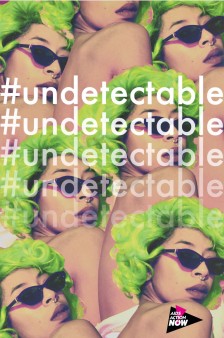Looking at public health campaigns about HIV, Alex McClelland felt that people living with the virus were often presented as a threat to the public. Hoping to change that messaging, McClelland and Jessica Whitbread founded PosterVirus, a Canadian-based project for which artists create posters about HIV, hepatitis C and related topics.
“In the history of AIDS activism, art has always been central to a lot of the work. We are trying to bring that back,” says McClelland, a 38-year-old PhD candidate in criminology who has been living with HIV since he was 19.
He and Whitbread, who are both Canadian, launched PosterVirus in 2011 (the project is an affinity group of AIDS Action Now and often includes U.S. artists). After a two-year hiatus, the project returned for World AIDS Day 2016 with a new lineup to provoke conversations.
Once completed, the posters are printed and displayed throughout Toronto a week before a Day Without Art, an annual event held on December 1 in conjunction with World AIDS Day that calls for action and mourning in response to the AIDS crisis. The posters can also be seen on the project’s official website, PosterVirus.tumblr.com.
So far, PosterVirus has worked with over 30 artists and produced about 25,000 posters. McClelland notes that artists are given complete freedom to create whatever they want for the project and that many collaborate on their work.
“PosterVirus was inspired by Gran Fury, General Idea, Fierce Pussy and many more from the early years of the AIDS crisis,” explains Whitbread, referencing groups that used graphic design and posters as a form of activism and education.
Nowadays, Whitbread adds, she finds inspiration in the artists she’s working with via PosterVirus. The 2016 lineup included Kia Labeija, Jessica Karuhanga, FASTWÜRMS, Shan Kelley and Brenden Fernandes.
Labeija, a New York artist, created a poster focusing on her newfound freedom as an HIV-positive woman who is now undetectable.
Reproducing a text message chat for her poster, Toronto-based artist Karuhanga explores what it’s like to have a Ugandan aunt whom she has never met die of an AIDS-related illness.
The poster from Canadian collective FASTWÜRMS is about loving people living with HIV in a world full of stigma and discrimination. Kelley, a Canadian artist and activist living with HIV, said his work is “intended to critique the culture of memorial, and the endless imperative to present publicly as healthy, happy and compliant.”
“I used the phrase ‘Dead tired of being so bloody positive’ to vocalize my anger at the surging tide of complacency I fear is rife within the movement against HIV,” Kelley says. He then elaborates on a list of his grievances that includes, “I’m dead tired of being overmedicated and undertreated. I’m dead tired of the expansiveness of the carceral state. I’m dead tired from the cries and tears of our indigenous sisters, our first peoples and the genocide of their communities. I’m dead from the villainization of people of color, and I’m gutted by their systematic brutalization. I’m dead tired that trans and nonbinary people still can’t so much as use a restroom without a court injunction, much less live in peace. HIV can never exist in isolation, and I’m dead tired of feeling powerless against its entanglement in the fabric of our world.”
Kelley hopes his poster will dignify anger as a unifying force and serve as an inspiration not to give up the fight for positive change.
Finally, Fernandes’s poster is about Truvada as pre-exposure prophylaxis (PrEP), the daily pill to prevent getting HIV. “In my poster, I think about it in a political, social space,” says Fernandes, a New York–based artist who sometimes works in Toronto. He notes that PrEP is a “somewhat privileged drug” because everyone doesn’t have equal access to it. “I want to create a dialogue,” adds Fernandes. “I want people to think about the responsibility. The understanding. The privilege. The future of what this drug does for us.”
“Art is a powerful form of activism,” Whitbread says. “It engages people at different levels and lets them react in their own time. There is an element of play in art, and it is a way to have difficult conversations.”













Comments
Comments